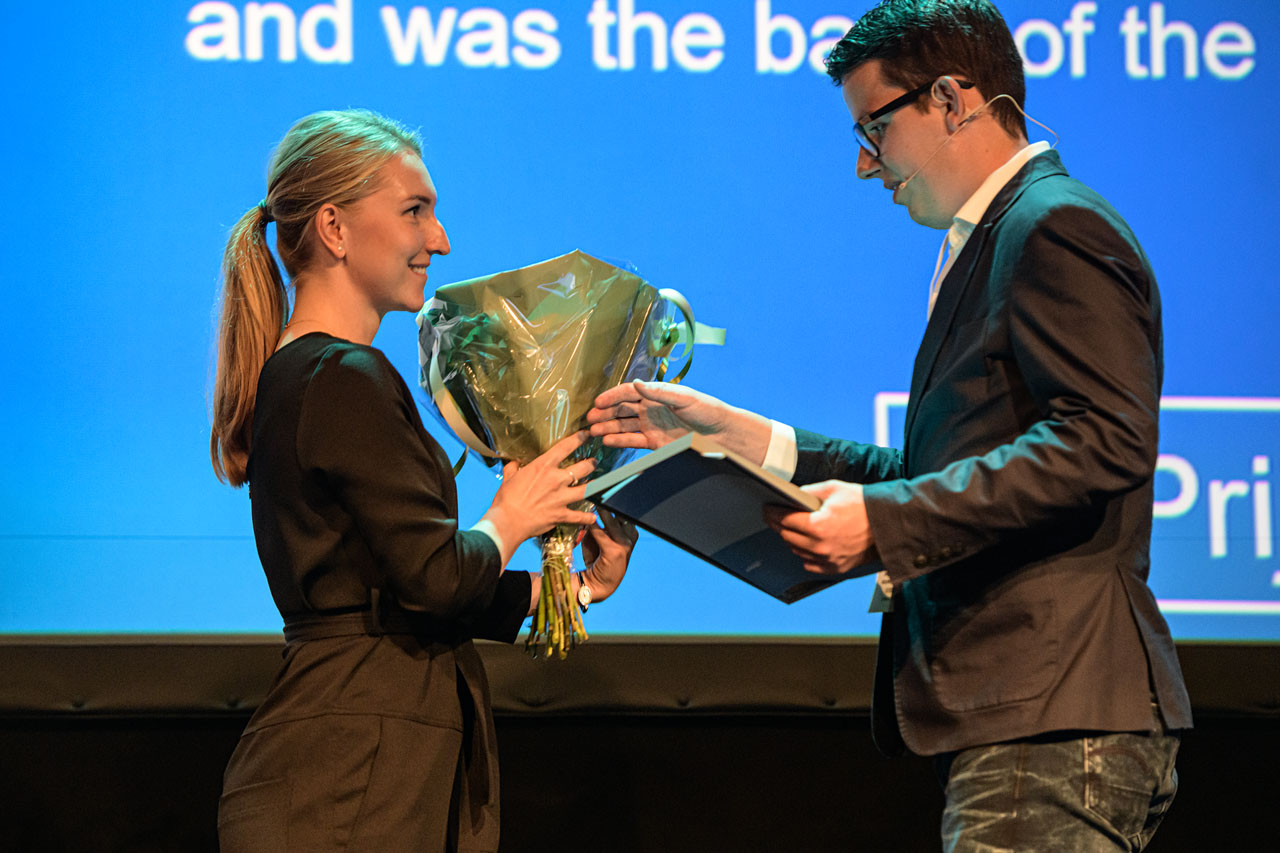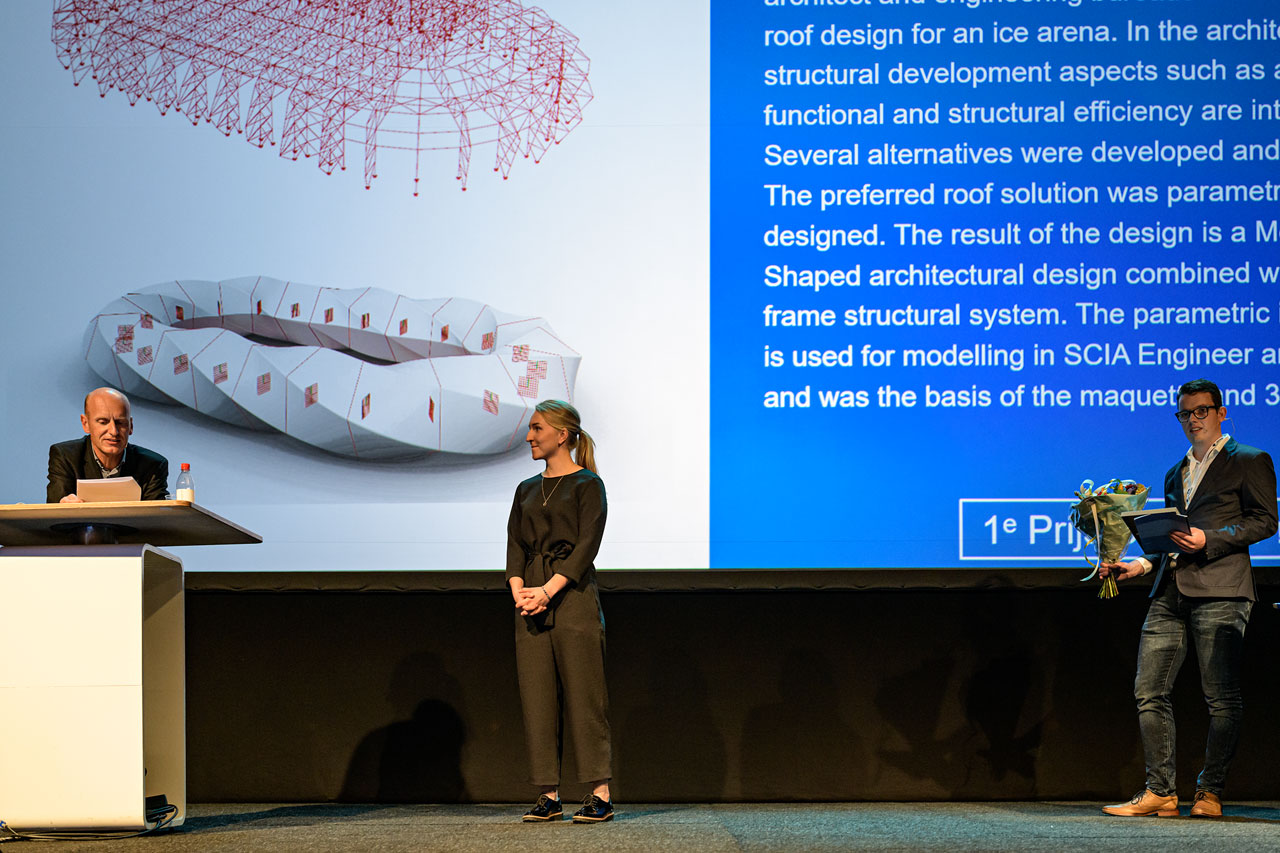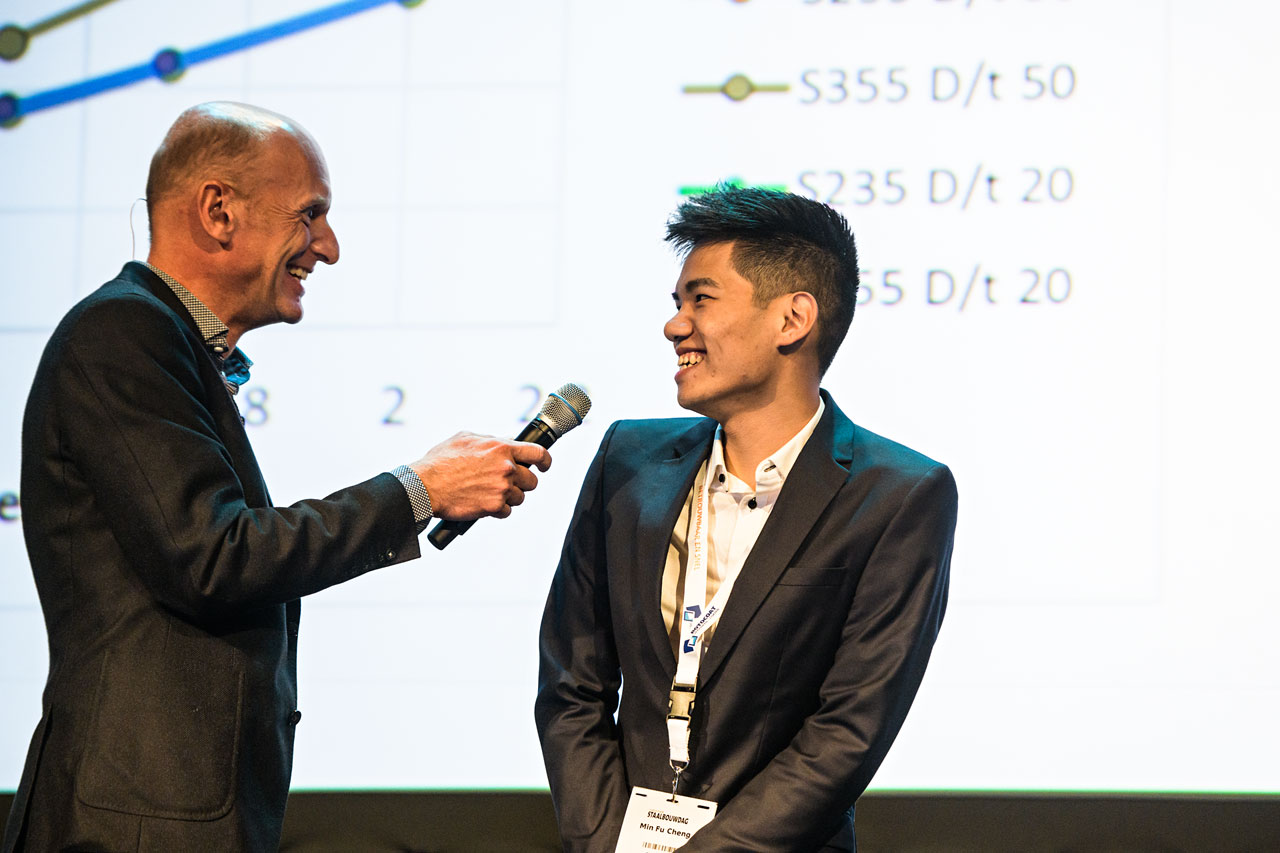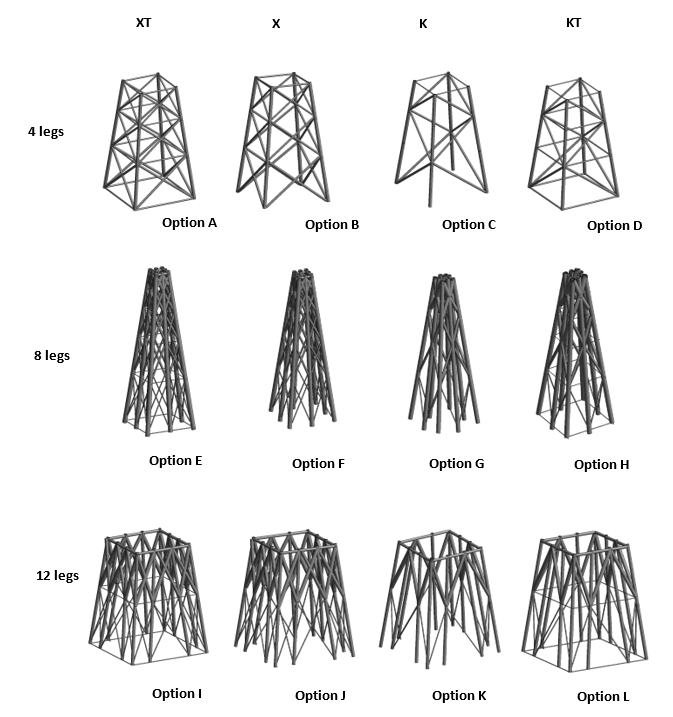Bachelor
In 2019 waren er twee inzendingen in de categorie Bachelor. Deze vielen beiden in de prijzen: er werden een eerste prijs en een tweede prijs uitgedeeld.
« terug naar StudentenSTAALprijs 2019 1e prijs: Daria Safonova (Hogeschool Zeeland, Middelburg & Iv-Consult) - Mobius Arena: Architectural and Structural Development of Ice Arena Roof
1e prijs: Daria Safonova (Hogeschool Zeeland, Middelburg & Iv-Consult) - Mobius Arena: Architectural and Structural Development of Ice Arena Roof
The graduation is done in engineering firm Iv-Consult and the thesis topic is provided by ZJA Zwarts & Jansma Architects. The architectural bureau requires a structural solution for the roof of an ice skating rink, which is the part of the sport complex project. Only the dimensions of the building and the main functional requirements are provided.
Although, the structural design of the arena roof is important, it is not enough to look at the research problem from the structural point of view only. An ice arena has very specific inner environmental conditions, has to provide safety and comfort of sportsmen and spectators. Moreover, the financial aspect requires solutions which will allow to minimize use of the energy to get correct ice surface and air conditions. This means that the roof design has to take into account the sustainability aspects and consider the latest developments of the ceiling and cladding design with low-e values.
 The minimized material use, together with the smart consideration of the roof future prospects such as constructability, maintainability, and demolition, can minimize the life-cycle costs. Another sustainability aspect for the structures nowadays is a post life-span demount ability and re-use of the structural elements. This have to be considered at the early design stages, by means of the structural system, used material, sizes of the elements, type of connections, etc.
The minimized material use, together with the smart consideration of the roof future prospects such as constructability, maintainability, and demolition, can minimize the life-cycle costs. Another sustainability aspect for the structures nowadays is a post life-span demount ability and re-use of the structural elements. This have to be considered at the early design stages, by means of the structural system, used material, sizes of the elements, type of connections, etc.
The designed roof is a large-span structure, therefore, not all of the structural systems can be applied. However, there are three general systems, with the use of steel: truss, arch and cable systems. They can be considered in various configurations and give an optimal solution with the above-mentioned functional aspects.
The last but not least, the future ice arena building, is a part of sport venue in the Netherlands. It is a massive construction which will attract attention of the public, possibly including national and international competitions. No need to explain how the visual perception is important. If the structural solution, together with the fulfilled functional and technical requirements, can be also aesthetically appealing, the value of the design will increase significantly.
Four concept studies were developed and the final alternative based on the multi-criteria analysis was chosen. After that, the winning alternative is parametrically developed as a final design of the current thesis project. Grasshopper is used for the geometry development and parametric load, nodes, supports and cross-sections input and linked to the SCIA Engineer. Geometry optimization for the minimized material use is done and final structure is verified for strength, stability and stiffness according Eurocode in SCIA Engineer. Moreover, within Grasshopper, Tekla Live-link is used and the final technical drawings with the parametric adjustments possibilities are obtained as one of the final products of the project.
The result of the design is a mobius-shaped architectural design combined with a portal frame structural system. The parametric information is used for modelling in SCIA Engineer and Tekla and was the basis of the maquette and 3D printing. The conclusion shows that the final design fulfills the consideration of all the requirements from the key-stakeholders for the following research and satisfies the minimum demands of the preliminary structural design.
Het oordeel van de jury:
De jury is zeer onder de indruk van de uitgebreide analyses waarbij een breed scala van randvoorwaarden is meegenomen die veel verder gaat dan een constructief en/of architectonisch uitgangspunt. Als het ware vanuit het niets is stap voor stap toegewerkt naar een draagconstructie en een vorm voor het stadion die het beste aan alle gestelde randvoorwaarden voldoen. Met een grenzeloze ijver is elk facet van het complexe programma van eisen onderzocht. Computermodellen en software zijn ingezet om tot een realistisch voorstel te komen. Het resultaat is een overtuigend integraal ontwerp waarin architectuur, constructie en staal elkaar versterken. Superlatieven voor dit afstudeeronderzoek buitelen over elkaar heen: ‘een perfect voorbeeld van parametrisch ontwerpen’, ‘niet te stuiten enthousiasme voor het vakgebied en vooral voor staal’, ‘overstijgt het bachelor niveau’, ‘ijver leidt tot ontwikkeling’. Unaniem en zonder discussie is dit afstudeeronderzoek de eerste prijs absoluut waard.
 1e prijs: Min Fu Cheng (Hogeschool Rotterdam & Royal HaskoningDHV) - Automated Designmodel for a jacket structure
1e prijs: Min Fu Cheng (Hogeschool Rotterdam & Royal HaskoningDHV) - Automated Designmodel for a jacket structure
Herhalende werkzaamheden in ontwerpprocessen zijn onnodig tijdrovend. Voor zijn afstudeeronderzoek heeft de afstudeerder een geautomatiseerd ontwerpmodel opgezet waarbij met minimale inspanning een groot aantal ontwerpvarianten kan worden geproduceerd. Door gebruik te maken van programmering binnen Excel (VBA) en Revit (Dynamo) worden simpele staalberekeningen zichtbaar uitgevoerd en verwerkt tot een 3D model. Dit ontwerpmodel is opgezet voor een offshore jacket constructie, waarbij de dimensies van de elementen afhankelijk zijn van de offshore invloeden (water diepte, golven, stroming, etc.)
 Alle parameters van de jacket constructie zijn onderzocht om een geautomatiseerd ontwerp model te kunnen creëren. Het geautomatiseerd model in dit onderzoek is meer dan een parametrisch model waarin de uitkomsten automatisch worden verkregen door het veranderen van de invoer parameters. In aanvulling hierop is een model geproduceerd dat de invoer gegevens automatisch kan veranderen om zo verschillende ontwerp varianten te creëren. Ook zijn repeterende werkzaamheden geautomatiseerd en zijn resultaten uitgewisseld tussen programma’s.
Alle parameters van de jacket constructie zijn onderzocht om een geautomatiseerd ontwerp model te kunnen creëren. Het geautomatiseerd model in dit onderzoek is meer dan een parametrisch model waarin de uitkomsten automatisch worden verkregen door het veranderen van de invoer parameters. In aanvulling hierop is een model geproduceerd dat de invoer gegevens automatisch kan veranderen om zo verschillende ontwerp varianten te creëren. Ook zijn repeterende werkzaamheden geautomatiseerd en zijn resultaten uitgewisseld tussen programma’s.
Het geautomatiseerde ontwerpmodel blijkt robuust en bevestigt dat de wegingsfactoren de ontwerpkeuze inderdaad sterk beïnvloeden. De betrouwbaarheid van het geautomatiseerde ontwerpmodel is getest door de uitkomst te vergelijken met het werkelijke uitgewerkte jacket ontwerp. Het geautomatiseerde model heeft slechts een kleine afwijking ten opzichte van het werkelijk uitgewerkte ontwerp.
Het oordeel van de jury:
De afstudeerder heeft een ‘tool’ ontwikkeld, waarmee complexe ontwerpopgaven eenvoudig hanteerbaar zijn gemaakt. Ondanks het feit dat er al veel onderzoek naar jacketconstructies is gedaan, is deze tool een leuke aanvulling. Het onderzoeksrapport toont een goede analyse naar de mogelijke inzet van een parametrisch ontwerp. Het uitgebreide rapport en het degelijke onderzoek overstijgen het bachelor niveau. ‘Knap gedaan!’


